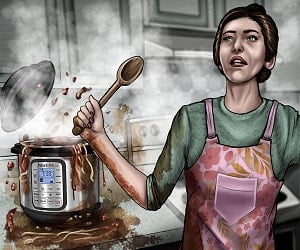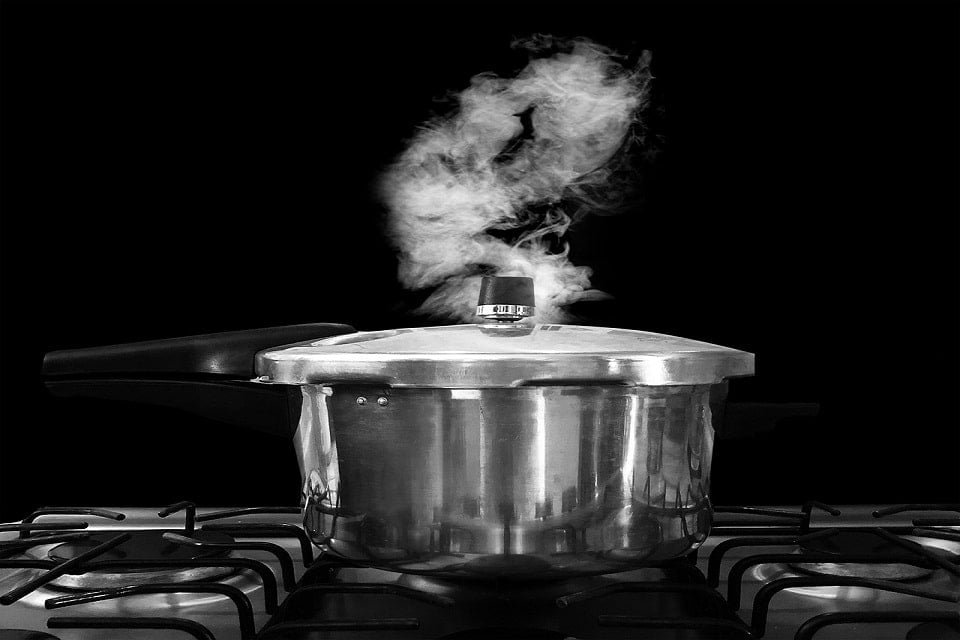Countertop pressure cookers, including popular brands such as Instant Pot and Crock-Pot, have long been popular for their convenience and speed in the kitchen. But despite the ease, pressure cookers and multi-cookers alike come with hazards that make us nervous, the most worrying being the idea of an explosion.
Indeed, some of these appliances have been dangerous and have been recalled. For example, in April of 2021, more than 900,000 Crock-Pot multi-cookers were recalled due to safety issues. These various recalls are the perfect illustration of how efficient but dangerous these appliances are; easier to use isn’t the same as safer to use.
We’re going to go over what causes a pressure cooker to explode and what could possibly happen, and safety measures to make sure that it doesn’t happen to you. What causes a pressure cooker to explode?
Understanding Pressure Cookers

While I will address the risks, it’s important to know how a pressure cooker works. When put under pressure, little steam can escape from a pressure cooker that is used to build up.
The pressure of the steam increases as the cooker heats up, causing the temperature inside the cooker to rise above the boiling point of water.
This high temperature allows food to cook much faster than with other methods, as the high heat and pressure in the cooker break down fibers and make everything more tender.
When not properly used, or malfunctions in the design or manufacturing of the cooker, dangerous situations could be created due to high pressure and temperature. Excessive pressure accumulation may cause the cooker to explode, and damage or serious personal injury or death.
TorHoerman Law stresses the importance of understanding the potential dangers and implications of a pressure cooker exploding. Suppose you or a loved one has been severely injured or burned as a result of such an incident. In that case, it is important to become familiar with your legal rights and available courses of action.
A pressure cooker explosion results from the pressure inside the pressure cooker exceeding the upper limit, blowing the pressure cooker into shreds. A number of factors might cause this perilous condition:
- Evidence the Cooker is Overfilled: Too much stuff or too much liquid in the pressure cooker can block the flow of steam, causing the pressure to rise above and beyond what the cooker can take.
- Obstructed Vent: The vent, or pressure release valve, is important to keep working properly. If clogged, the steam may not be able to escape, which can build pressure.
- Damaged Seals: The safety valve and the seal of the pressure cooker are the ones that are responsible for controlling the pressure, and you can not underestimate them. Today’s models, such as electric pressure cookers, use the technology to let off steam safely. When in use, just about anyone can also rest assured that it only expels benign vapors or condensation.
- Misuse: Pulling out the gasket without following any directions – This is being replicated with a half-open lid even with half gasket pulled out and put back – Spillage – Rusting due to water sitting for extended periods – Usage on gas flame at maximum flame capacity – Tackling alone any problem with the cooker as cooker juggles are placed for lifting the 3 kg plus weight of the cooker and meals – Rusting due to use of non ISI Graded aluminium causing pitting Wear and Tear: – Overfilling, heating without water, using metal spatulas to remove food, not lifting the cooker from the gas very carefully can affect the bottom of the body.
Consequences of Pressure Cooker Explosions
The results of a pressure cooker explosion are serious and may even be fatal. The force from such a blast can force hot fluids, food, or metal shards in all directions, including on the person making the coffee, and cause burns, scalds, and even serious injury to anyone in its path. The explosion in itself might also cause damage to things around it, such as property, or even start a fire.
Preventing Pressure Cooker Explosions through Safety Practices
Fortunately, there are a few precautions you can take to avoid the pressure cooker blowing up:
- Read the Manual: Ignorance is not bliss, in kitchen appliances at least. Manuals exist for a reason- they guide in the process, providing a detailed (and sometimes simple) way through the problems encountered. By opening up and reading through that manual, you’ll know how to steer your way through pressure cooking with boldness and a grain of salt.
- Good Ventilation: Make sure the pressure release valve and vent tube are clear of debris, and you can blow through them freely. Be sure to check these parts periodically to ensure they stay in working order.
- Enough Liquid: Make sure there is enough liquid in the pressure cooker when using 8. Too little fluid can result in too much pressure.
- Do Not Overfill: Do not fill the cooker over the maximum fill line. Overfilling clogs the steam passages and may result in dangerous pressure.
- Maintenance and Check: 1. Please check the sealing ring/washer frequently to see if there are no loose, different, or damaged parts. Change as needed according to the manufacturer’s recommendation. Keep other parts like the lid clean and good condition.
- Release Only On Low Pressure: Follow the release method as recommended, letting pressure out on low pressure only. Please do not open the cooker forcefully or before it is sufficiently cooled.
- Stay Vigilant: Do not leave a pressure cooker unsupervised while it is in use. Check the pressure levels and listen for any abnormal sounds or behaviors regularly.
Conclusion
Pressure cookers and Instant Pots are essential kitchen appliances that can save you time cooking dinner. But you should be aware of the risks of pressure cooker explosions if you want to use one safely. Suppose you adhere to the safety guidelines given and take care of the cooker as recommended.
In that case, it can easily minimize the risk of a disastrous pressure cooker blast. Don’t forget, your best bet for using the pressure cooker without seriously endangering your wellbeing is to play it safe and follow the manufacturer’s instructions.

